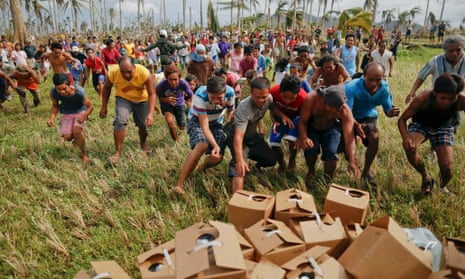“Look at my house – it’s like a pigsty! My neighbours are lucky. They get to live as human beings, while this — this is for pigs.” In Cando’s community, where shanties display identical wooden walls and shiny white iron roofs, his house sticks out, looking askew and incomplete. His walls are sheets of corrugated iron tied together with a plastic tarpaulin as a makeshift roof, making the interiors stiflingly hot.
Cando was excluded from relief distribution due to his small family size. Targeting – the practice among humanitarian agencies of prioritising the needs of the most vulnerable – is common, but what impact is it having on those who are excluded?
When responding to huge disasters such as super typhoon Haiyan, which killed more than 8,000 people and displaced more than 4 million in central Philippines, humanitarian agencies operate with their own resource limitations and targets. So agencies entering a village will, typically, distribute goods only to the most vulnerable families in the area. For example, families with five or more children, or with a person with a disability, are more likely to be included in distributions than smaller-sized families or families with members working overseas. The assumption is automatically made that these families are better-resourced and as a result they are less likely to receive aid.
But the unfortunate result of this process seems to be social division, especially within tight-knit communities. As part of the Pamati Kita project, we spent several months interviewing people in some of the disaster-affected villages affected by Haiyan, and we were struck by how the excluded families felt resentful and ashamed by this process.
In our interviews, excluded people express bitterness even if they were often unsure who they should be angry at. Should it be the agency creating these selective criteria, governmental officials producing aid lists or neighbours who have received more from humanitarian workers?
Our respondents’ experiences suggest that selective relief distributions spark status anxiety. Intensified by traditional Filipino village relations where neighbours are regarded as extended family and people’s sense of dignity (pagkatao) is defined by their status in the community, status differences marked by small luxuries hit the have-nots hard. We met people who have had to borrow money from relatives or others in the community and incur debts in the process just to keep up with their neighbours’ vegetable gardens.
This neighbour envy can lead to feedback channels such as SMS hotlines being used to squeal on neighbours perceived to be undeserving of humanitarian aid and some agencies use this feedback to “correct” their future distribution lists. People suddenly cut off from aid then feel the need to conduct witch-hunts in retaliation to try and figure out which neighbour reported them to agencies, setting off paranoia within friendship groups.
Because neighbours size up each other’s access to humanitarian relief, some strategically withdraw from the community, keeping their relief stories secret so as to avoid incurring the envy of their friends.
In other Filipino communities, affected peoples organise among themselves and negotiate with humanitarians and government officials to eschew lists and instead redistribute relief evenly to all residents, even if it means that each family receives fewer relief goods.
Although humanitarians learned early on that many communities expressed a preference for agency distributions where “everyone gets a little something”, some agencies were unable to act on this feedback due to the high pressure to meet their committed targets. At the same time, a few agencies instituted different practices of having aid workers embedded within local communities in order to immediately resolve disputes and respond quickly to issues. The question remains as to whether targeting procedures are incompatible within the Filipino cultural context.
What is clear is that being excluded from humanitarian aid creates more than just an economic burden of having to find alternative means to secure shelter or a source of livelihood. It also leaves a deep emotional imprint in people that may manifest as shame and jealousy in neighbourly interactions. While humanitarians aim to serve the needs of the most vulnerable, each community is irreversibly transformed as their actions cause new material inequalities that are lived and felt in everyday life.
Although need has traditionally been the “north star” that guides humanitarian activities, we find that in the case of Haiyan, this value conflicts with other indicators of good performance, such as a community’s increased sense of solidarity in the wake of humanitarian projects.
So what should you do? Well, when discussing the hidden injuries of humanitarian relief, it is important to emphasise the importance of community consultations to understand local customs and preferences, especially as Filipino village cultures traditionally emphasise values of neighbourly cooperation and mutual obligation to care for each other.
Yes, of course disaster calls for an urgent response. But humanitarians must also pay attention to local sensitivities. After all, community wellbeing after disaster depends not only on addressing people’s material needs. It also depends on maintaining the affected people’s social connections with their neighbours, their village and with the wider world.
Dr Jonathan Corpus Ong is a sociologist and humanitarian consultant, working on disasters and ICTs. You can follow him @jonathan_c_ong
Join our community of development professionals and humanitarians. Follow @GuardianGDP on Twitter.

Comments (…)
Sign in or create your Guardian account to join the discussion